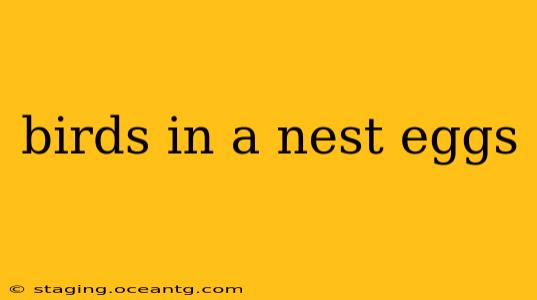Birds' nests are fascinating structures, meticulously crafted to protect developing eggs and their vulnerable young. The sight of a bird nestled on its eggs evokes a sense of wonder and curiosity. This comprehensive guide delves into the intricacies of bird nests, eggs, and the fascinating behaviors surrounding them.
What are the different types of bird nests?
Bird nests exhibit remarkable diversity, reflecting the wide array of bird species and their unique nesting strategies. Some birds build elaborate structures, while others opt for simpler nests. We can broadly categorize nests into several types:
- Cup nests: These are the most common type, shaped like a cup or bowl to hold the eggs and chicks. Robins, cardinals, and many songbirds construct cup nests.
- Platform nests: These are large, flat nests built on sturdy branches or platforms. Ospreys, eagles, and herons create platform nests that can be used for years.
- Cavity nests: Some birds nest in pre-existing cavities, like tree holes or crevices in cliffs. Woodpeckers excavate their own cavities, while others, such as owls and bluebirds, utilize natural or abandoned cavities.
- Scrape nests: The simplest type, scrape nests are shallow depressions on the ground, often lined with minimal materials. Ground-nesting birds like Killdeer and many shorebirds use scrape nests.
- Pendant nests: These are intricately woven nests suspended from branches, often showcasing remarkable engineering feats. Weaver birds are masters of constructing pendant nests.
What kind of eggs do birds lay?
Bird eggs vary enormously in size, shape, color, and markings. These variations are often linked to the nesting environment and the bird's evolutionary history.
- Size and Shape: Egg size is directly correlated to the size of the bird. The shape can vary from oval to pointed, depending on the nesting location and the need to prevent the eggs from rolling away.
- Color and Markings: Egg colors range from pure white to a multitude of shades, including blues, greens, browns, and even speckled patterns. The camouflage offered by coloration helps protect the eggs from predators.
- Egg Shell Composition: Bird eggshells are primarily composed of calcium carbonate, providing strength and protection for the developing embryo. The shell's porosity allows for gas exchange while maintaining the egg's structural integrity.
How many eggs do birds lay in a nest?
The number of eggs a bird lays in a single clutch (a set of eggs laid at one time) varies greatly depending on the species, the availability of food, and other environmental factors. Some species lay only one egg, while others may lay a dozen or more. This number is often referred to as the clutch size.
How long does it take for birds' eggs to hatch?
Incubation periods differ significantly across bird species. Smaller birds generally have shorter incubation periods than larger birds. Factors like ambient temperature and the species' incubation behavior also play a role. Incubation periods can range from a few weeks to several months.
What happens after the eggs hatch?
Once the eggs hatch, the chicks are completely dependent on their parents for food and protection. The parental care provided varies among species. Some birds provide extensive care, while others offer minimal assistance after hatching. The period of parental care can extend for several weeks or even months, until the fledglings are able to fend for themselves.
How do birds choose their nest location?
Bird nest site selection is a critical process involving various factors. Birds consider several elements, including:
- Protection from predators: A hidden location reduces the risk of predation.
- Availability of resources: Proximity to food and water sources is vital for raising young.
- Structural stability: The nest site must provide a secure foundation for the nest.
- Climatic conditions: The location should provide appropriate shelter from harsh weather conditions.
What are some common bird nest parasites?
Several species, such as the Brown-headed Cowbird, are known for their brood parasitism. These birds lay their eggs in the nests of other species, leaving the host bird to raise the parasitic young. This behavior can have detrimental consequences for the host birds, potentially leading to a reduction in their reproductive success.
Understanding the diverse world of bird nests and eggs reveals the remarkable adaptations and intricate behaviors of these fascinating creatures. Further research into specific bird species will only deepen your appreciation for the intricate details of their nesting strategies and reproductive success.
